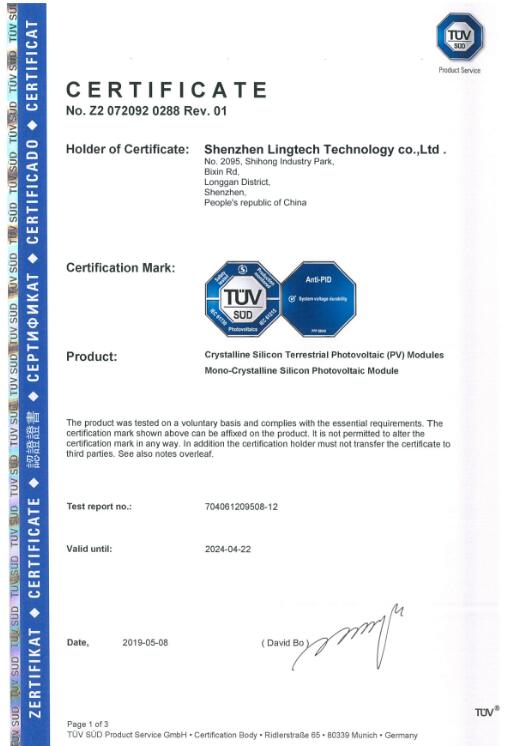
PID TEST
The invention relates to a potential-induced attenuation test method for silicon solar modules, which relates to the field of solar module testing technology. The test method is as follows: prepare three modules of the same specification, randomly select one as the control part, and the other two as the components to be tested; Firstly, the component is pretreated with a certain intensity of sunlight exposure. After the pretreatment, the initial test is carried out, including the appearance, insulation performance, electrical performance,EL test and wet leakage current test of the component. During the test, the leakage current value was recorded. After the test, the component was taken out for a period of recovery and tested for insulation performance,EL, moisture leakage and electrical performance. It is used to evaluate the ability of solar modules to withstand system bias, and test the ability of solar modules to withstand system voltage, humidity, temperature and other environmental factors at a reasonable cost and time. It has guiding significance to reduce and prevent PID phenomena.
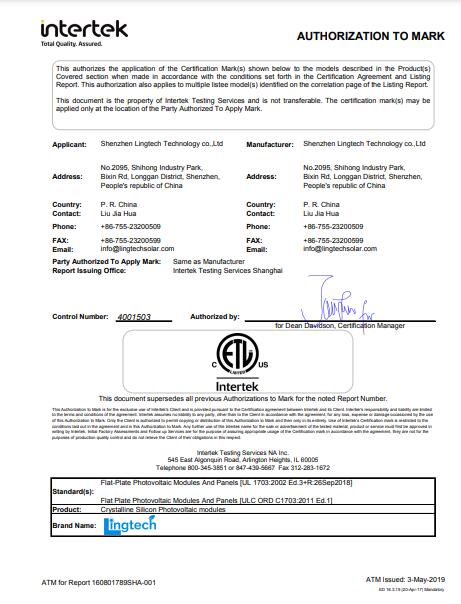
ETL TEST
ETL is short for the electronic test lab (ElectricalTestingLaboratories). ETL laboratory was founded by The American inventor Thomas Edison in 1896 and enjoys a high reputation in the United States and the world. Like UL and CSA, ETL may issue ETL certification marks according to UL standards or US national standards tests, or may issue composite certification marks according to UL standards or US national standards and CSA standards or Canadian standards tests. The bottom-right representation applies to the United States, the bottom-left representation applies to Canada, and both have and apply to both countries.
ETL also requires that its manufacturing site has been inspected and the applicant agrees to conduct regular follow-up inspections of its factory thereafter to ensure that the product consistently meets this requirement.
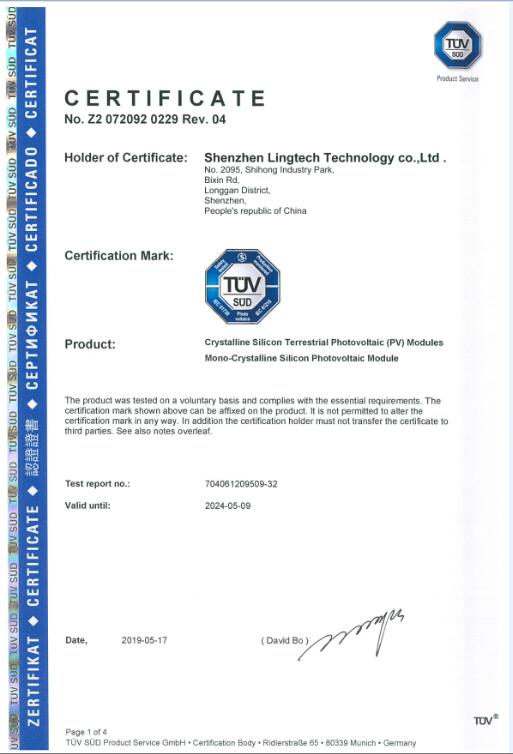
IEC61730 PV SAFETY TEST
This part of IEC 61730 specifies the experimental requirements for photovoltaic modules in order to provide safe electrical and mechanical operation as expected and to evaluate protection measures against electrical shock, fire and personal injury caused by mechanical or external environmental effects. IEC 61730-1 sets out the structural requirements, while IEC 61730-2 sets out the test requirements.
IEC61730-1
This standard applies to the basic construction requirements of solar photovoltaic (PV) modules in order to provide safe electrical and mechanical operation over their expected life. Assess the prevention of electrical shock, fire and personal injury caused by mechanical and environmental stresses. Attempts to define basic requirements for various application classes of solar photovoltaic modules, but does not cover all national or regional building codes, and does not cover specific requirements for Marine and automotive applications. This standard does not apply to modules with integrated AC converters (AC modules). The sequence of tests described in this standard may not test all possible safety considerations for PV modules in all possible applications. This standard uses the best test sequence available. Some problems, such as the potential hazard of electric shock from broken modules in high voltage systems, should be noted in system design, location, access restrictions, and maintenance procedures. Types of tests include: general inspection, electric shock hazard, fire hazard, mechanical stress and environmental stress.
IEC61730-2
IEC 61730-2 the testing requirements of the part of the solar cells, solar cells at different application levels of detail as much as possible the basic requirements, to provide security within the time limit in the intended use of the electrical and mechanical operation requirements, and aimed at the mechanical or external environment influence caused by electric shock, fire and personal injury protection measures for evaluation. The purpose of this test is to protect the operator from electric shock and personal injury caused by contact with live parts of the component due to errors in design, construction or environmental operation.
Iec61730-2 test type (six categories) : pretreatment test, basic inspection, voltage hazard test, fire test, mechanical pressure test, structure test.
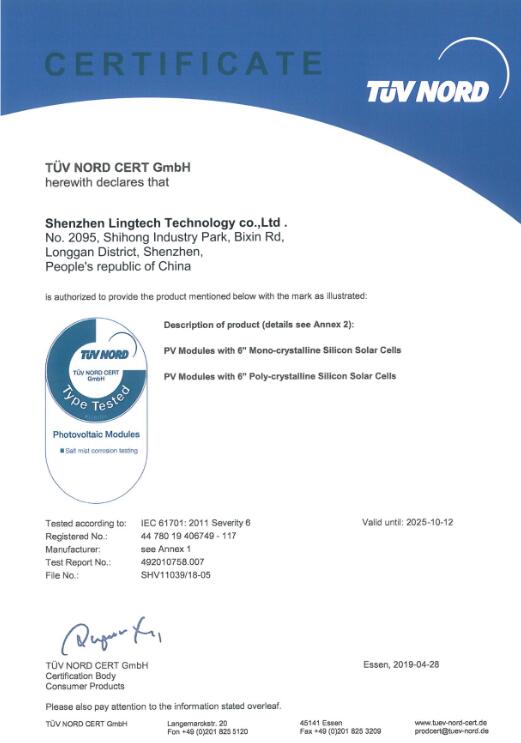
SALT MIST CORROSION TEST
Salt spray test is an environmental test which mainly uses artificial simulated salt spray environment conditions created by salt spray test equipment to examine the corrosion resistance of products or metal materials. It is divided into two categories, one is natural environment exposure test, the other is artificial accelerated simulated salt spray environment test. Artificial simulated salt spray environment test is a kind of test equipment with a certain volume space — salt spray test chamber, in its volume space by artificial method, to create a salt spray environment to evaluate the corrosion resistance of products.
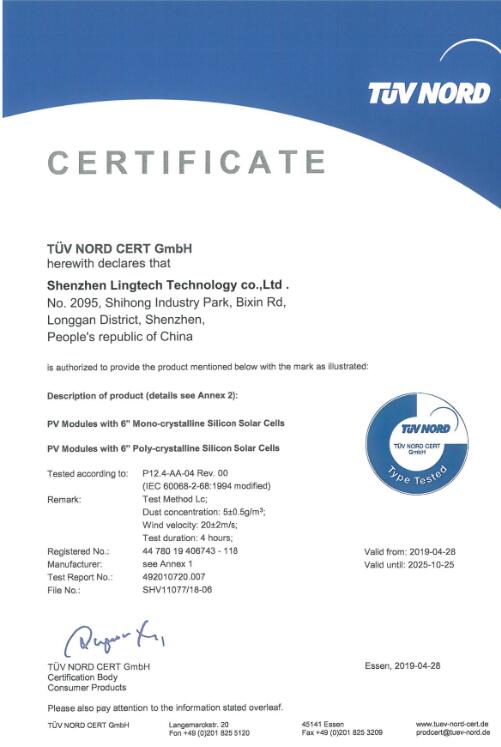
SAND DUST TEST
The sand test mainly simulates the erosion effect of severe sandstorms. Through a series of rigorous tests on the modules, the applicability and durability of solar photovoltaic products in desert environment and other extreme environmental conditions are ensured, so as to ensure that the modules can play the best effect in real environment. It plays an important role in determining the reliability and durability of solar cell modules in real environment.
A solar cell module that has been certified by sand testing shows that it can be installed and work effectively in desert areas with little rain and dust, which means it can withstand the effects of high-speed sand particles on surfaces.

UL CERTIFICATE

ISO9001 CERTIFICATE
Quality management system is a systematic quality activity established within an organization to ensure product quality or quality objectives. It selects a number of system elements to be combined according to the characteristics of the organization, strengthens the quality management activities from the whole process of design and development, production, inspection, sales and use, and institutionalizes and standardizes, becoming the requirements and activity procedures of the internal quality work of the organization.
ISO9001 international quality management system certification is based on ISO9000 family standards. ISO stands for international Organization for Standardization. ISO9000 standards include five categories of standards, the core part of which is quality assurance and quality management guide two categories of standards.

ISO14001 CERTIFICATE
ISO 14001 environmental management system: it is the integration of many developed countries in the world in environmental management experience in one and formed a complete, scientific, operational system standards. The standard requires effective control of the whole process of production, from the initial design to the final products and services, to reduce the emission of pollution and the impact on the environment. Through the establishment of objectives, indicators and management plans to control important environmental factors, to reduce or completely avoid the discharge of pollutants beyond the standard.
All through the certification of enterprises, in the production plant use of raw materials, technology, processing methods and the use of products and disposal are in line with environmental protection standards and regulatory requirements.

ISO45001 CERTIFICATE
This standard sets out the requirements and guidelines for the use of an occupational health and safety management system to enable organizations to provide healthy and safe working conditions to prevent work-related injuries and health impairments while proactively improving occupational health and safety performance. This includes considering applicable legal and regulatory requirements and other requirements and developing and implementing occupational health and safety policies and objectives.